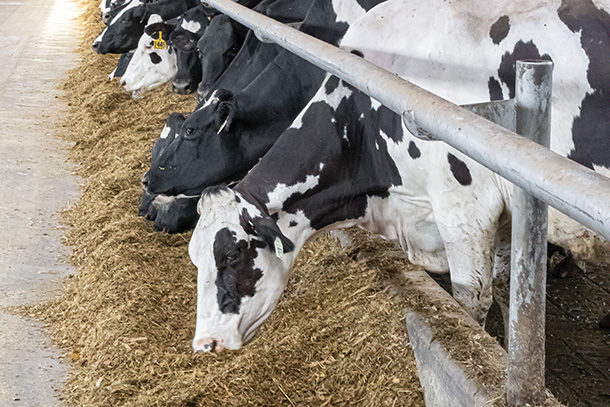It might not seem like much when you walk through the barn and notice an empty feedbunk. The feed truck eventually drops a pile of feed, and the cows dive in to eat. All seems right with the world. While this may be the perception, reality tells a much different story. That period of reduced intake likely caused a fair amount of stress to the cow’s digestive system, doing more harm than many producers realize.
Remember that cows are creatures of habit and prefer as much consistency in their day as possible. The same goes for the rumen and its microbial community. Ideally, a steady flow of nutrients enters the rumen day in and day out, providing a constant supply of energy to the rumen bugs and, ultimately, to the cow herself.
In situations where a cow goes off feed, that flow of nutrients shuts off, affecting important metabolic and physiological processes and putting her at risk for multiple digestive and immunological challenges.
Several factors can cause cows to go off feed:
- An empty bunk: It sounds simple, but keeping fresh feed in front of cows can be an issue on dairy farms. The causes vary, but could include changes in dry matter content, an increase in pen size without changing the amount of feed delivered, a feeder who makes a mistake or an equipment malfunction. Realize that the implications of an empty feedbunk are greater for overstocked pens. Cows not aggressive enough to fight their way to the bunk will have a larger off-feed deficit than the pen average.
- Calving: Feed intake by cows during the three weeks before calving can drop 33% and as much as 88% in the last week before calving. This reduction in intake can have a dramatic impact on rumen function, emphasizing the importance of an effective transition cow management program.
- Environmental stressors: Heat stress can be especially hard on feed intake. When that happens, it is important to put appropriate heat abatement measures in place to maintain intakes as much as possible.
- Diseases and disorders: Cattle impacted by bovine viral diarrhea (BVD) can have as much as an 80% reduction in feed intake. Cows with transition disorders like hypocalcemia, mastitis or metritis can experience a drop in intake by as much as 50%.
Understanding GI tract function
To understand the disruption caused by off-feed events, it is important to understand the multiple roles played by the cow’s gastrointestinal (GI) tract. The primary responsibility of the GI tract is the digestion of feedstuffs. This includes the absorption of short-chain fatty acids (SCFAs), minerals and other key nutrients in the ration.
A second function involves creating a protective barrier that stands as the first line of defense for the immune system. This barrier regulates the flow of materials in and out of the GI tract, protecting the animal from pathogens and other harmful substances while allowing nutrients to flow freely into the bloodstream. A third function is communicative, facilitating crosstalk between the host and the microbiome, as well as nutrient sensing and signaling. A healthy gut is able to perform all three of these critical functions optimally.
Research shows that reduced feed intake can be detrimental to each of these functions.
- A study in Germany exposed animals to 48 hours of complete feed withdrawal. Compared to animals that were not subjected to this treatment, absorption of SCFAs was reduced by 50%.
- A University of Saskatchewan study evaluated the impact of different levels of reduced feed intake. In the study, 18 Angus heifers were fed diets at 75%, 50% and 25% of their voluntary feed intake. The heifers were all fed the same diets and their recovery was tracked for three weeks once feed intake was restored. Heifers that experienced the greatest reduction in feed intake during the treatment period (25% of their voluntary intake) had the following reactions:
- Reduced production of SCFAs
- Reduced capacity of the rumen and small intestine to absorb nutrients
- Reduced protective barrier function of the GI tract
- Reduced ruminal pH in the recovery period once normal feed intake was restored
- In a study from Iowa State University, low feed intake resulted in a systemic inflammatory response and altered intestinal morphology.
A long recovery
In addition to the previously mentioned challenges, studies have shown that recovery after an off-feed event can be extensive. In the Saskatchewan study, recovery took the longest in heifers that experienced the greatest reduction in intake (25% of their voluntary feed intake). Although their ruminal pH was highest during the period of feed restriction (a result of reduced SCFA production), pH was reduced drastically when normal levels of intake were restored.
A study showed a 50% reduction in the absorptive surface area of the rumen following a period of low feed intake. A reduction in the ability of the rumen to absorb SCFAs could explain why cattle are at a greater risk of developing ruminal acidosis following an off-feed event.
Based on the results of these studies, periods of low feed intake can have a significant impact on the long-term health of dairy cows. Implementing management strategies to avoid off-feed events can pay dividends. Following strict feeding protocols to prevent empty feedbunks is an important first step. Avoiding overcrowding so all animals within a pen have access to feed is also highly recommended.
One specific opportunity lies in the transition period. As described previously, a rapid drop in feed intake prior to calving can have a detrimental effect on ruminal absorptive capacity. When combined with a highly fermentable diet, SCFAs can easily accumulate in the rumen, making fresh cows especially susceptible to subacute ruminal acidosis. Therefore, if possible, producers should consider offering fresh cows a high-forage diet for two or three days after calving before transitioning them to a more energy-dense ration.
References omitted but are available upon request by sending an email to the editor.











